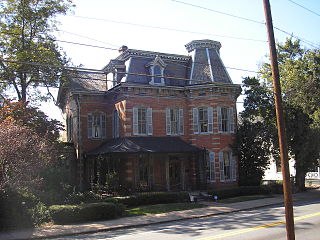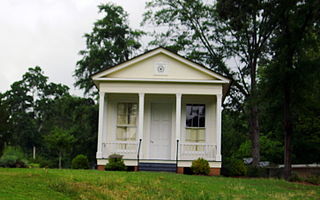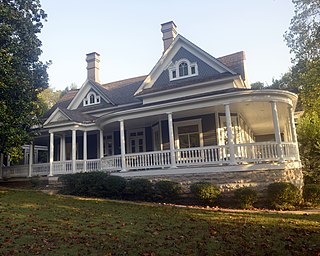
The Harrison Courthouse Square Historic District is an area of Harrison, Arkansas. It is known by residents simply as "the Square". The Harrison Courthouse Square Historic District includes the 1911 Boone County Courthouse, two pharmacies, several clothing stores and restaurants, and a Marine Corps Legacy Museum. The District also has a bank and the Lyric Theater. The District is the site of several annual festivals, including Crawdad Days and the Fall Festival. Several war memorials stand on the Courthouse lawn. The Square is known as the site of the shooting of famous outlaw Henry Starr.

Hillcrest Historic District is an historic neighborhood in Little Rock, Arkansas that was listed on the National Register of Historic Places on December 18, 1990. It is often referred to as Hillcrest by the people who live there, although the district's boundaries actually encompass several neighborhood additions that were once part of the incorporated town of Pulaski Heights. The town of Pulaski Heights was annexed to the city of Little Rock in 1916. The Hillcrest Residents Association uses the tagline "Heart of Little Rock" because the area is located almost directly in the center of the city and was the first street car suburb in Little Rock and among the first of neighborhoods in Arkansas.
This is an incomplete list of historic properties and districts at United States colleges and universities that are listed on the National Register of Historic Places (NRHP). This includes National Historic Landmarks (NHLs) and other National Register of Historic Places listings. It includes listings at current and former educational institutions.
The Goodall House was a historic house located at 618 Orange Street in Macon, Georgia. It was built in 1859 with Italianate exterior and ornate interior. As of 1971, it had been very little altered and it was listed on the National Register of Historic Places. Despite opposition from local preservationists, the house was demolished in 1975 and replaced with an office building.

U.S. Route 62 is a U.S. highway running from El Paso, Texas northeast to Niagara Falls, New York. In the U.S. state of Arkansas, the route runs 329.9 miles from the Oklahoma border near Summers east to the Missouri border in St. Francis, serving the northern portion of the state. The route passes through several cities and towns, including Fayetteville, Springdale, Bentonville, Harrison, Mountain Home, Pocahontas, and also Piggott. US 62 runs concurrent with several highways in Arkansas including Interstate 49 and U.S. Route 71 between Fayetteville and Bentonville, U.S. Route 412 through much of the state, U.S. Route 65 in the Harrison area, and with U.S. Route 63 and U.S. Route 67 in northeast Arkansas.
The University of Arkansas Campus Historic District is a historic district that was listed on the National Register of Historic Places on September 23, 2009. The district covers the historic core of the University of Arkansas campus, including 25 buildings.
Morrow House may refer to:

The Harrison High School is a public high school serving ninth through twelve grade students in Harrison, Arkansas, United States.

The Boone County Courthouse is a historic courthouse in Harrison, Arkansas. It is a two-story brick structure, designed by noted Arkansas architect Charles L. Thompson and built in 1907. It is Georgian Revival in style, with a hip roof above a course of dentil molding, and bands of cast stone that mark the floor levels of the building. It has a projecting gabled entry section, three bays wide, with brick pilasters separating the center entrance from the flanking windows. The gable end has a dentillated pediment, and has a bullseye window at the center.
The Boone County Jail is a historic jail building at Central Ave. and Willow St. in Harrison, Arkansas. It is a two-story red brick building, built in 1914. Its design has been attributed to prominent Arkansas architect Charles L. Thompson. Its hip roof is finished in red tile, as is the roof of the single-story porch sheltering the main entrance. The jail was laid out to house the jailer on the first floor, and the prisoners on the second.

The Cowles–Woodruff House, listed on the National Register of Historic Places as the Cowles House and also known as the Woodruff House or the Cowles–Bond House, is owned by Mercer University in Macon, Georgia and is located at 988 Bond Street. It is an antebellum home the overlooks downtown Macon. It was used by General James H. Wilson as his residence and headquarters during the occupation of Macon by the US Army in 1864. From 1960 to 1978 it was the campus of Stratford Academy.

The Hatcher-Groover-Schwartz House is a historic residence in Macon, Georgia, that was built in 1880. It was listed on the National Register of Historic Places in 1971. It is located at 1144-1146 on Georgia Avenue, in the historic center of Macon.

The Leake–Ingham Building is a historic commercial building in Camden, Arkansas. It is located behind the McCollum-Chidester House at 926 Washington Street NW, and is part of the Ouachita County Historical Society Museum. It is one of the oldest commercial buildings in Camden. The single-story Greek Revival structure was built c. 1850 by William Leake, a prominent Camden attorney, and has a distinctive Greek temple front. It was originally located on a prominent corner of the city, at Washington and Harrison Streets. Leake operated a law practice from the building until 1866 with various partners, after which it was used to house government offices, and later Camden's first library. Threatened with demolition in the 1950s, it was moved several times before its acquisition by the historical society.
The Duncan House is a historic house in 610 West Central Avenue in Harrison, Arkansas. It is a 1+1⁄2-story wood-frame structure, with asymmetrical massing and a busy roofline typical of the Queen Anne style. Distinctive features include metal cresting on the ridge lines, and a wraparound porch with tapered columns and turned balustrade. An octagonal cupola caps the roof. The house was built in 1893 by William Duncan, a local builder, for his own use. It is one of Harrison's few remaining houses of the period which has retained its Queen Anne features.

The Evans-Kirby House is a historic house at 611 South Pine Street in Harrison, Arkansas. It is a two-story wood-frame structure on a sandstone foundation, with a busy roofline and asymmetrical massing typical of the Queen Anne style. The roof is punctuated with five dormers of different sizes and shapes, and the walls are finished with clapboards and decoratively-cut shingles. The porch is adorned with spindled friezes and brackets. The property also includes a period barn/carriage house and garage, the latter over an original smoke cellar. The house was built in 1895 for Dr. E.L. Evans, who sold it in 1906 to his brother-in-law, Dr. Frank Kirby.

The Haggard Ford Swinging Bridge is a historic suspension bridge in Boone County, Arkansas. It is located adjacent to Cottonwood Road, about 8 miles (13 km) north of Harrison, and spans Bear Creek. It has cast-in-place concrete abutments, towers, and anchorages, and is supported by steel cables. A wooden deck, one travel lane in width, is suspended from steel hangers. The bridge is about 160 feet (49 m) long. The bridge was built 1938–41 with funding from the Works Progress Administration. Fill surrounding the abutments was washed away in 1945 and subsequently replaced. The bridge deck was replaced in 1977.
Twelve Oaks, or the J.W. Bass House, is a historic farm estate at 7210 Arkansas Highway 7 South in rural Boone County, Arkansas, south of Harrison. The main house is a dramatic and architecturally eclectic two-story building with a variety of Craftsman, Colonial Revival, and Mission style details. It is a stucco-finished concrete construction, whose roof has exposed rafter tails, and was originally finished in tile, replaced after a 1973 tornado extensively damaged the property. At the time of its construction in 1922, it was one of the finest plantation houses in the state. It was built by J. W. Bass, a businessman responsible for the construction of a number of Harrison's finest buildings, who developed a 1,600-acre (650 ha) farm south of the city, with this property as its centerpiece. It was named "Twelve Oaks" after a grove of twelve large oak trees, none of which survived the 1973 tornado.

The Harp Creek Bridge is a historic bridge in rural northern Newton County, Arkansas, carrying Arkansas Highway 7 across Harp Creek in the hamlet of Harrison. It is an open-spandrel arch bridge, built out of reinforced concrete in 1928 by the Luten Bridge Company. The arches span 69 feet (21 m), and are mounted on piers set 24 feet (7.3 m) from the abutments. The total structure length is 117 feet (36 m), and the deck is 23 feet (7.0 m) wide. Concrete balustrades line the sides of the bridge.

The Goodwin-Harrison House is a historic mansion in Macon, Mississippi, U.S.. It was built in 1852 for W. W. Goodwin, a planter. It was designed in the Greek Revival architectural style. From 1873 to 1882, it was home to a boys' school run by W. W. Baird. It was purchased by Nathaniel H. Harrison, a banker, in 1882. It has been listed on the National Register of Historic Places since November 28, 1980.

The Uncle Dave Macon House is a historic house in Readyville, Tennessee, U.S.. It was built as a log cabin in 1843. It was purchased by country music performer Uncle Dave Macon in 1900. He resided there until his death in 1952. It has been listed on the National Register of Historic Places since November 15, 1973.















